The Adaptive Stroller Market is estimated to be valued at USD 552.6 million in 2025 and is projected to reach USD 998.9 million by 2035, registering a compound annual growth rate (CAGR) of 6.1% over the forecast period.
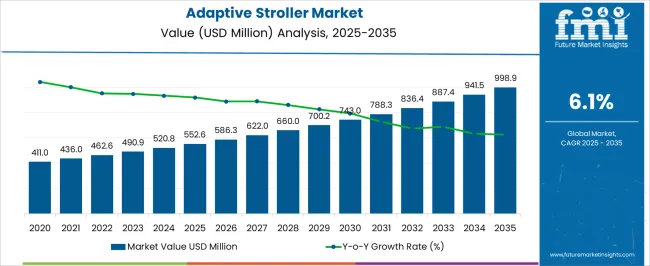
| Metric | Value |
|---|---|
| Adaptive Stroller Market Estimated Value in (2025 E) | USD 552.6 million |
| Adaptive Stroller Market Forecast Value in (2035 F) | USD 998.9 million |
| Forecast CAGR (2025 to 2035) | 6.1% |
The adaptive stroller market is experiencing steady growth, supported by increasing demand for mobility solutions tailored for children with special needs. The market is being driven by rising awareness of pediatric mobility challenges and the growing emphasis on enhancing quality of life for children with physical and neurological disabilities. Healthcare professionals and caregivers are prioritizing adaptive equipment that ensures both safety and comfort, thereby fueling demand for strollers with advanced ergonomic features.
The increasing incidence of conditions requiring mobility support, combined with broader insurance coverage and government assistance programs, is contributing to stronger adoption rates across developed and emerging regions. Manufacturers are focusing on product innovations that offer lightweight materials, adjustable seating, and customizable support to cater to diverse user requirements.
With rising global attention toward inclusivity and accessibility, adaptive strollers are being recognized as essential equipment in rehabilitation and home care environments The market outlook remains positive as ongoing product advancements and expanding healthcare infrastructure continue to create favorable opportunities for sustained growth worldwide.
The adaptive stroller market is segmented by product, application, and geographic regions. By product, adaptive stroller market is divided into Single Seats and Multiple Seats. In terms of application, adaptive stroller market is classified into Cerebral Palsy, Developmental Delay, Spinal Muscular Atrophy, Traumatic Brain Injury, and Others. Regionally, the adaptive stroller industry is classified into North America, Latin America, Western Europe, Eastern Europe, Balkan & Baltic Countries, Russia & Belarus, Central Asia, East Asia, South Asia & Pacific, and the Middle East & Africa.
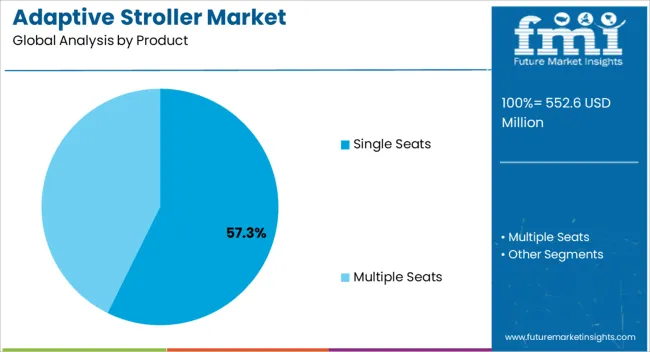
The single seats product segment is projected to hold 57.3% of the adaptive stroller market revenue share in 2025, making it the leading product type. Its dominance is being supported by the practicality, ease of maneuverability, and affordability that single-seat designs offer to caregivers. These strollers are lightweight, compact, and easier to transport, which enhances their appeal for daily use in both home and outdoor environments.
The design also provides optimal positioning and stability, ensuring greater comfort and safety for children with mobility challenges. Increasing adoption is being driven by their suitability for individual care, particularly in households where personalized mobility support is prioritized. Manufacturers have enhanced single-seat strollers with adjustable seating systems, foldable frames, and improved cushioning, making them adaptable to different age groups and conditions.
Their widespread availability across multiple price points has further reinforced accessibility in both developed and developing regions As affordability and ease of use continue to influence caregiver choices, the single-seat category is expected to maintain its leadership in the adaptive stroller market.
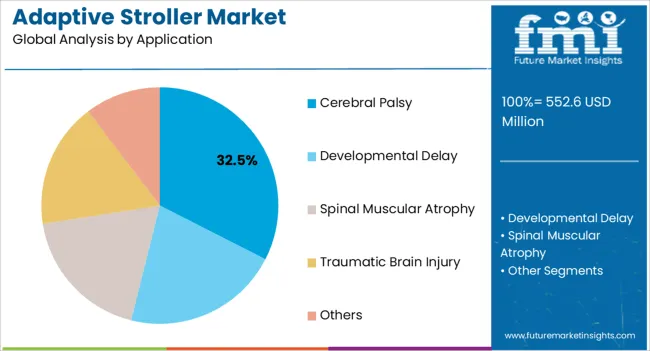
The cerebral palsy application segment is anticipated to account for 32.5% of the adaptive stroller market revenue share in 2025, positioning it as the leading application area. This leadership is being reinforced by the high prevalence of cerebral palsy as one of the most common neurological conditions requiring long-term mobility support. Adaptive strollers designed for children with cerebral palsy provide specialized seating and posture correction features that improve daily comfort and mobility.
Their usage is being driven by the necessity for equipment that ensures safety, reduces caregiver strain, and facilitates participation in everyday activities. Governments and healthcare systems are increasingly prioritizing support for cerebral palsy patients, offering funding assistance that encourages adoption of adaptive mobility devices.
Manufacturers are responding to this demand by developing strollers with enhanced lateral support, tilt-in-space adjustments, and modular accessories to address specific therapeutic requirements As awareness and early diagnosis of cerebral palsy continue to rise, the demand for strollers catering to this segment is expected to expand, reinforcing its role as the dominant application in the market.
This development is likely to create lucrative prospects for key players in the adaptive strollers industry, which is estimated to drive the global growth of the adaptive strollers market. Owing to different key drivers in the industry.
One notable trend in the adaptive stroller industry is the increasing incorporation of advanced materials and technology aimed at enhancing durability, comfort, and overall functionality.
Lightweight materials such as aluminum and high-strength plastics are being utilized to make strollers more user-friendly. A growing trend towards customization, with key players in the industry offering bespoke options to cater to the specific needs of individual users.
Another significant trend is the rise in e-commerce and online sales channels. As consumers become more comfortable with online shopping, key players in the adaptive strollers industry are leveraging digital platforms to reach a broader audience, offering detailed product descriptions, virtual consultations, and even virtual try ons to aid purchasing decisions.
One of the primary drivers for the adaptive stroller market size expansion is the increasing prevalence of physical disabilities and mobility issues among children. The rise in incidence has heightened the demand for specialized mobility solutions that cater to the unique needs of these children.
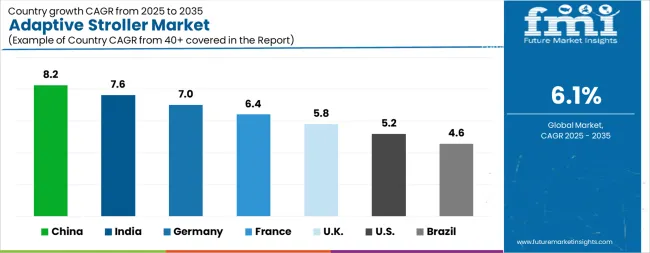
| Country | CAGR |
|---|---|
| China | 8.2% |
| India | 7.6% |
| Germany | 7.0% |
| France | 6.4% |
| UK | 5.8% |
| USA | 5.2% |
| Brazil | 4.6% |
The Adaptive Stroller Market is expected to register a CAGR of 6.1% during the forecast period, exhibiting varied country level momentum. China leads with the highest CAGR of 8.2%, followed by India at 7.6%. Developed markets such as Germany, France, and the UK continue to expand steadily, while the USA is likely to grow at consistent rates. Brazil posts the lowest CAGR at 4.6%, yet still underscores a broadly positive trajectory for the global Adaptive Stroller Market. In 2024, Germany held a dominant revenue in the Western Europe market and is expected to grow with a CAGR of 7.0%. The USA Adaptive Stroller Market is estimated to be valued at USD 205.8 million in 2025 and is anticipated to reach a valuation of USD 341.2 million by 2035. Sales are projected to rise at a CAGR of 5.2% over the forecast period between 2025 and 2035. While Japan and South Korea markets are estimated to be valued at USD 27.8 million and USD 18.4 million respectively in 2025.
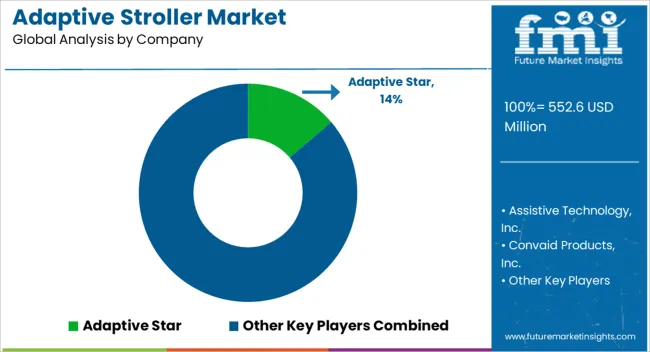
| Item | Value |
|---|---|
| Quantitative Units | USD 552.6 Million |
| Product | Single Seats and Multiple Seats |
| Application | Cerebral Palsy, Developmental Delay, Spinal Muscular Atrophy, Traumatic Brain Injury, and Others |
| Regions Covered | North America, Europe, Asia-Pacific, Latin America, Middle East & Africa |
| Country Covered | United States, Canada, Germany, France, United Kingdom, China, Japan, India, Brazil, South Africa |
| Key Companies Profiled | Adaptive Star, Assistive Technology, Inc., Convaid Products, Inc., Deming Designs Inc., Eurovema Ab, Invacare Corporation, Meyra, Ormesa, Performance Health, Special Tomato, Sunrise Medical LLC, Thomashilfen.us., R82 Inc., and Bergeron Health Care |
The global adaptive stroller market is estimated to be valued at USD 552.6 million in 2025.
The market size for the adaptive stroller market is projected to reach USD 998.9 million by 2035.
The adaptive stroller market is expected to grow at a 6.1% CAGR between 2025 and 2035.
The key product types in adaptive stroller market are single seats and multiple seats.
In terms of application, cerebral palsy segment to command 32.5% share in the adaptive stroller market in 2025.






Our Research Products

The "Full Research Suite" delivers actionable market intel, deep dives on markets or technologies, so clients act faster, cut risk, and unlock growth.

The Leaderboard benchmarks and ranks top vendors, classifying them as Established Leaders, Leading Challengers, or Disruptors & Challengers.

Locates where complements amplify value and substitutes erode it, forecasting net impact by horizon

We deliver granular, decision-grade intel: market sizing, 5-year forecasts, pricing, adoption, usage, revenue, and operational KPIs—plus competitor tracking, regulation, and value chains—across 60 countries broadly.

Spot the shifts before they hit your P&L. We track inflection points, adoption curves, pricing moves, and ecosystem plays to show where demand is heading, why it is changing, and what to do next across high-growth markets and disruptive tech

Real-time reads of user behavior. We track shifting priorities, perceptions of today’s and next-gen services, and provider experience, then pace how fast tech moves from trial to adoption, blending buyer, consumer, and channel inputs with social signals (#WhySwitch, #UX).

Partner with our analyst team to build a custom report designed around your business priorities. From analysing market trends to assessing competitors or crafting bespoke datasets, we tailor insights to your needs.
Supplier Intelligence
Discovery & Profiling
Capacity & Footprint
Performance & Risk
Compliance & Governance
Commercial Readiness
Who Supplies Whom
Scorecards & Shortlists
Playbooks & Docs
Category Intelligence
Definition & Scope
Demand & Use Cases
Cost Drivers
Market Structure
Supply Chain Map
Trade & Policy
Operating Norms
Deliverables
Buyer Intelligence
Account Basics
Spend & Scope
Procurement Model
Vendor Requirements
Terms & Policies
Entry Strategy
Pain Points & Triggers
Outputs
Pricing Analysis
Benchmarks
Trends
Should-Cost
Indexation
Landed Cost
Commercial Terms
Deliverables
Brand Analysis
Positioning & Value Prop
Share & Presence
Customer Evidence
Go-to-Market
Digital & Reputation
Compliance & Trust
KPIs & Gaps
Outputs
Full Research Suite comprises of:
Market outlook & trends analysis
Interviews & case studies
Strategic recommendations
Vendor profiles & capabilities analysis
5-year forecasts
8 regions and 60+ country-level data splits
Market segment data splits
12 months of continuous data updates
DELIVERED AS:
PDF EXCEL ONLINE
Adaptive Shapewear Market Size and Share Forecast Outlook 2025 to 2035
Adaptive Cruise Control and Blind Spot Detection Market Analysis - Size, Share, and Forecast Outlook 2025 to 2035
Adaptive Optics Market Size and Share Forecast Outlook 2025 to 2035
Adaptive Microemulsions Market Analysis - Size and Share Forecast Outlook 2025 to 2035
Adaptive Cruise Control System Market Size and Share Forecast Outlook 2025 to 2035
Adaptive Camouflage Materials Market Size and Share Forecast Outlook 2025 to 2035
Adaptive Steering Market Size and Share Forecast Outlook 2025 to 2035
Adaptive Front Lighting Market Growth - Trends & Forecast 2025 to 2035
Adaptive Cruise Control Market - Size, Share, and Forecast 2025 to 2035
Adaptive Authentication Market Insights - Growth & Forecast 2025 to 2035
Adaptive Access Control Market Growth – Trends & Forecast through 2034
Baby Strollers & Prams Market Size & Demand 2024-2034
Shelf-Adaptive Geometry Packs Market Analysis - Size and Share Forecast Outlook 2025 to 2035
Demand for Adaptive Shapewear in Japan Size and Share Forecast Outlook 2025 to 2035
Demand for Adaptive Shapewear in USA Size and Share Forecast Outlook 2025 to 2035
Automotive Adaptive Lighting Market

Thank you!
You will receive an email from our Business Development Manager. Please be sure to check your SPAM/JUNK folder too.
Chat With
MaRIA